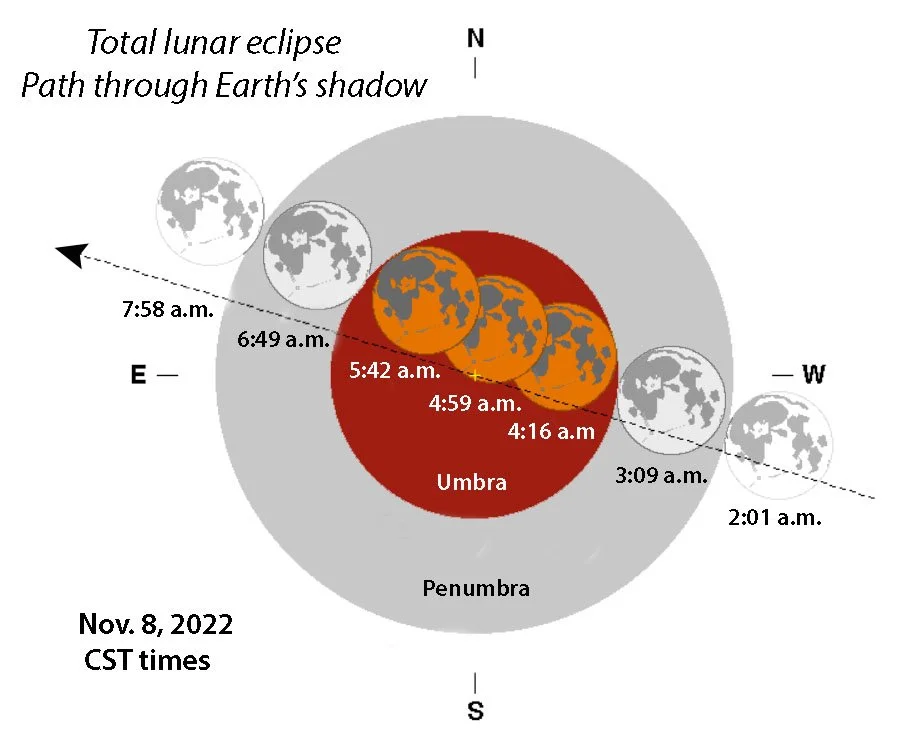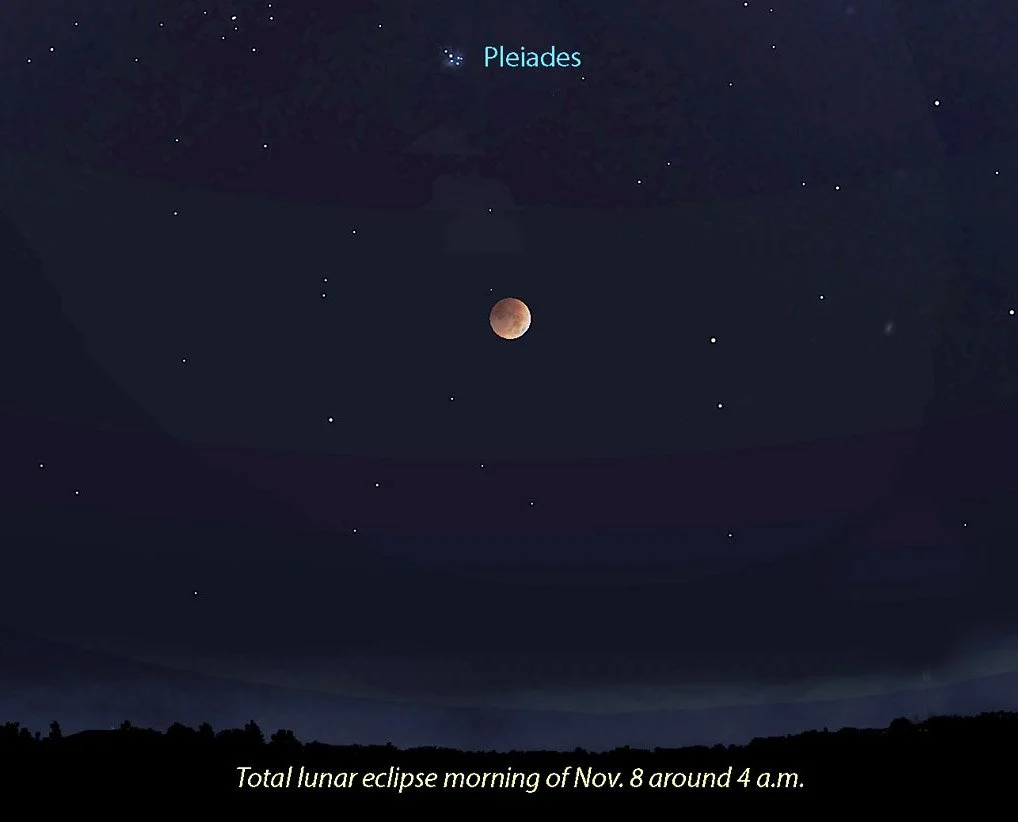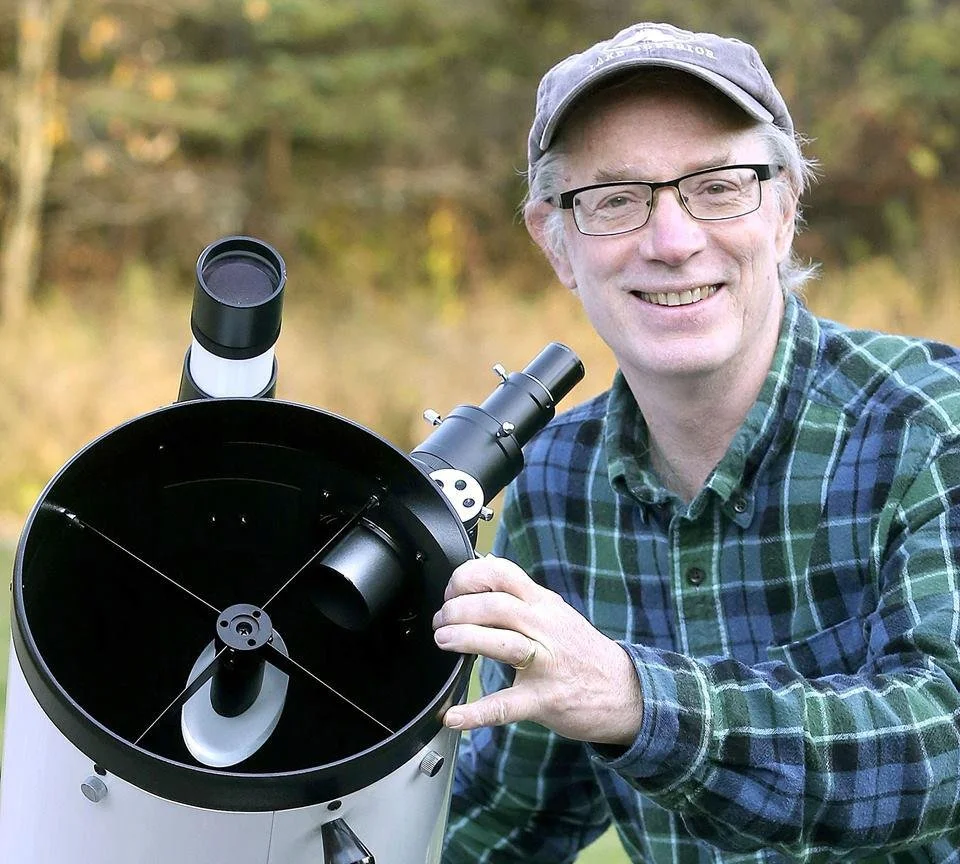November 2022 Night Sky Calendar
Jupiter dominates the sky this month. To see it just face southeast as soon as it gets dark. The planet looks like a brilliant, pale-yellow star. A steadily-held pair of 7x or 10x binoculars will reveal at least a couple of its brightest moons nestled within the planet’s glare. Be sure to focus sharply.
The big event this month is the total lunar eclipse that occurs during the early morning of Nov. 8, the same day as the election. Bundle up! For U.S. and Canadian observers, it happens during the early morning hours. You don’t need any equipment to watch the eclipse, but a pair of binoculars will enhance the view especially during totality when the moon hangs like a ripe peach among the stars.
Lunar eclipses last several hours so take your time. As more and more of the moon slips into Earth’s shadow, the sky darkens and the stars return. The change of light feels magical. Our next total lunar eclipse will occur on March 14, 2025 – a long way off.
*Note: When “a.m.” follows the date, it refers to an event primarily visible in the morning sky after midnight. All times are Central Daylight Time (CDT) until Nov. 6, when we return to Standard Time (CST).
Mosaic of the Nov. 19, 2021 total lunar eclipse from Duluth, Minn. Credit: Bob King
Events:
Nov. 1 – First quarter moon passes below the planet Saturn tonight
Nov. 1-12 – Peak of the Northern and Southern Taurid meteor showers. While only a handful of meteors per hour will be visible from most locations, fireballs are common. The meteors shoot from the direction of the bright, dipper-shaped star cluster the Pleiades, a.k.a. the Seven Sisters. Best viewing will be from 9 p.m. till 2 a.m. Face east or south. Moonlight interferes early in the month.
Nov. 4 – Waxing gibbous moon shines below Jupiter. Bright and eye- catching sight!
Nov. 6 – Daylight Saving Time ends
Nov. 8 a.m. – Full Beaver Moon. Total eclipse! Times CST:
Credit: Fred Espenak / NASA's GFSC
2:45 a.m. − First hint of shading along the moon’s upper left edge as it enters Earth’s outer shadow (penumbra)
3:09 a.m. – Partial eclipse begins as the moon enters Earth’s dark inner shadow (umbra)
4:16 a.m. – Total eclipse begins
4:59 a.m. – Mid-eclipse
5:42 a.m. – Total eclipse ends
6:49 a.m. – Partial eclipse ends
7:15 a.m. – Last hint of shading along the moon’s lower right edge
If you just want to catch the juiciest part, look between 3:45 – 4:30 a.m. CST.
Nov. 10 – Waning gibbous moon appears to the west of Mars, which
now shines with a brilliance equal to Sirius, the brightest star.
Nov. 16 – Last quarter moon
Nov. 18 a.m. – Peak of the annual Leonid meteor shower with around 10 meteors per hour visible between 1 a.m. and dawn local time from a dark location. Face east or south. Meteors stream from the constellation Leo, midway up in the southeastern sky around 3 a.m. A thick, waning crescent moon will reduce meteor counts a bit.
Simulated view of the moon during total eclipse on Tuesday morning, Nov. 8. Credit: Stellarium
Nov. 23 – New moon
Nov. 28 – Waxing crescent moon shines below Saturn
Nov. 30 – First quarter moon
Bob King is an amateur astronomer, author, and passionate educator. He served as a photographer and photo editor at the Duluth News Tribune for 39 years and taught at the UMD planetarium. Bob’s work had a great impact on Voyageurs National Park. To achieve International Dark Sky Park certification, the park was required to host dark sky education events. Through the Night Sky Explorer webinars, the Conservancy was able to fulfill this component and help secure the certification for Voyageurs National Park. We can’t thank Bob King enough for sharing his talents and knowledge with the Conservancy community to support dark sky preservation.




